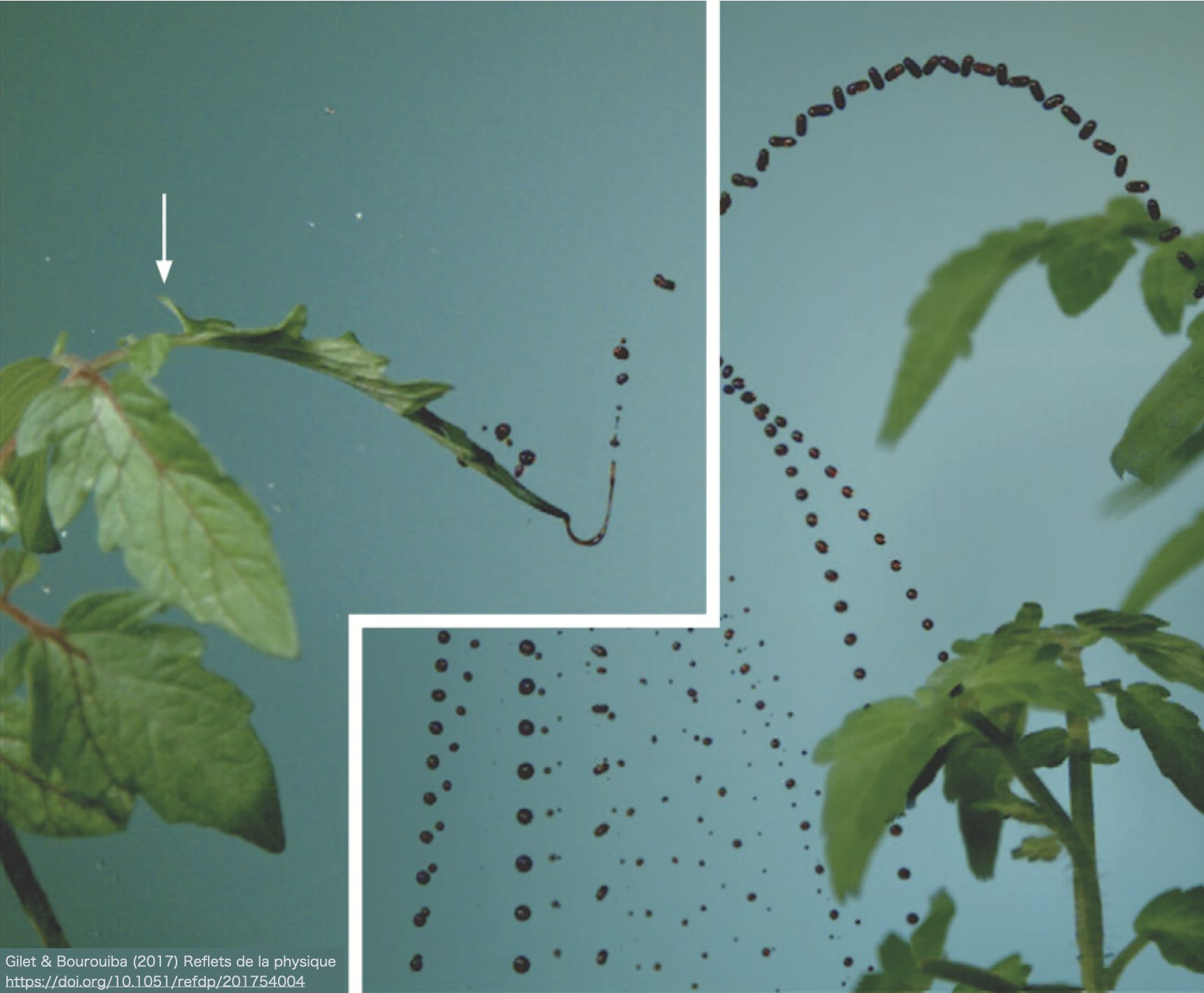New study demonstrates how fluid-pathogen interaction can shape contamination

Pathogen removal and ejection from moving surfaces and plant leaves
How sessile water droplets detach from moving surfaces and leaves might not be a common everyday thought. To scientists interested in how diseases spread from one plant to the next, it’s an important part of the puzzle to understand. For example, when dew forms on a leaf that is infected with a pathogen, the pathogen will contaminate the dew drops. When a rain drop then lands on the leaf and pushes it down, the bouncing leaf causes the contaminated droplet to detach and catapult, a process called inertial attachment. Understanding how the leaf’s sudden acceleration affects the transport of pathogens is crucial in controlling plant-to-plant disease spread. It is also critical for understanding retention of sprayed pesticides or other protective sprays in addition to fundamentally informing the physics of coating and spraying in a wide range of applications also in industry, and also broader health applications aiming to understand propagation of pathogens in fluids that break into sprays, e.g., exhalations.
In a paper published in the Journal of Fluid Mechanics, researchers from MIT and Sorbonne University examined the dispersal of pathogens through inertial detachment. The researchers wanted to understand how this sudden motion affects the dispersal of pathogens that may be present in droplets on moving surfaces such as crop leaves. This is particularly important for plants/crops with highly compliant leaves whose surfaces are of intermediate wettability, that are neither too hydrophobic nor too hydrophilic. The study’s results demonstrate that the process is not just effective in removing pathogens or contaminants from the leaves, but also in distributing them far away. Fragmentation of droplets through inertial detachment proved more effective than a splash method that was the focus of an earlier investigation, especially in crops with high leaf compliance.
Prof. Lydia Bourouiba, in the MIT departments of Civil and Environmental Engineering, Mechanical Engineering, and the Institute for Medical Engineering and Science, says one surprising finding was the robust selection of the size of the primary ejected droplet and that such size was largely independent of the force of impact.
“The size of the primary droplet ejected remains surprisingly consistent in this problem, no matter how hard the surface is moved, as long as the impact reaches a high enough impulse to overcome capillary adhesion forces and generate fragmentation,” says Bourouiba.

The researchers initially expected that more forceful impacts, imparting higher impulse to the leaf surface, would create smaller primary ejected droplets, but they found that the main primary ejected droplet was instead always about 70-80% of the original sessile drop’s size.
“Our research showed that for surfaces that have intermediate wetting, like crop leaves, i.e., which are moderately sticky, the liquid’s contact line dynamics and early dynamics in the droplet region close to the surface play important roles in selecting the primary ejected drop size early on in the deformation,” added Bourouiba.
This unexpected outcome highlights the important need to understand impulsive fragmentation and intermediate wetting processes that have been neglected compared to the more extreme configurations of superhydrophobic or wetting surfaces that are more often studied. Wettability or wetting, in this context, is the macroscopic manifestation of both the material properties of the leaf surface and its texture.
The researchers designed an experimental platform to mimic the real-world forcings that could trigger droplet ejection from impulsive processes, like rapid motion of plant leaves upon rain drop impact, wind, or irrigation. The platform employed a spring system and an actuator to generate controlled impulses, recapitulating a range of constant accelerations experienced by leaves in natural settings. This controlled acceleration mechanism allowed the team to study the effects of varying impulse strengths and surface wettability on droplet detachment. They also used high speed imaging to provide a visual record of the fluid dynamic process to analyze the stages of droplet deformation into a fluid ligament, ligament breakup and droplet detachment, as well as measure the sizes and determine the trajectories of the ejected droplets.
The researchers co-developed the experiments with theory and validated numerical simulations to gain a deeper understanding of the dominant underlying mechanisms driving the inertial detachment and selection of sizes of the ejected droplets.
Bourouiba says the combination and iterations between experimental observations, modeling, and simulations was critical to shed light on the surprising finding that the primary drop size selection occurs very early in the process, even prior to the visible formation of the canonical liquid ligament.
The insights gained are important for a range of environmental and health processes, where understanding the selection of load in pathogen-bearing droplets formed from a contaminated fluid bulk is key. Fundamentally, the insights gained from this study could also be applied to develop numerical modeling and benchmarking that can serve process optimization involving contact line and fragmentation dynamics prevalent in health and industrial settings.
“Impulsive acceleration and ligament fragmentation are ubiquitous in shaking, washing, exhalations, and other natural processes. Understanding how these processes affect the propagation and removal of contaminants like chemical compounds or pathogens from contaminated sources. Our findings could also lead to the development of optimized washing and decontamination protocols that remove contaminants effectively and efficiently,” says Bourouiba.
“What is particularly exciting and intriguing is that our results suggest that for hydrophilic/wetting pathogens, different densities may be carried in different sized droplets moving at different speeds; while water-repelling pathogens are primarily carried in the largest tip drop typically reaching the furthest in this system. Certain species of microorganisms may have adapted their properties to harness such selective transport for their advantage,” says Bourouiba.
Bouroubia’s co-authors include MIT postdocs Naijian (Eric) Shen and Timothy Jamin from The Fluid Dynamics of Disease Transmission in the Fluids and Health Network.
The research was supported, in part, by the USDA-NIFA Specialty Crop Research Initiative Grant Award no. MDW-2016-04938, the Richard and Susan Smith Family Foundation, the National Science Foundation, the Centers for Disease Control and Prevention-National Institute for Occupational Safety and Health and the National Institute of Allergy and Infectious Diseases of the National Institutes of Health under award number 5P01AI159402
Headline image: Reflets Phys.
Simulation of inertial detachment of droplet with wetting tracer pathogens such as a range of bacteria that initially distribute within different horizontal layers in the drop are tracked over time.
Simulation of inertial detachment of droplet with hydrophobic tracer pathogens such as a range of spores that initially distributed along the drop surface are tracked over time.


